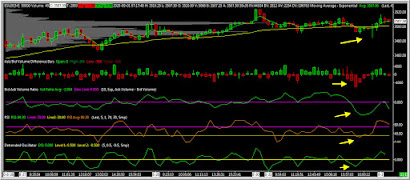Monday, August 31, 2020
More Ways Of Finding Edges With Momentum And Value
Friday, August 28, 2020
Actively Trading Momentum and Value In The Stock Market
So let's begin simply. We're interested in the percentage of stocks in the SPX universe that close each day above their respective five-day moving averages. (Data can be found via the Index Indicators site). That provides an indication of what I call breadth strength: the degree to which there is broad strength or weakness in the market.
My database goes back to August of 2014, so let's see what happens in the market after five days of broad strength and weakness. To accomplish that, I first divide the dataset into quartiles and examine average forward returns. When we have seen the broadest strength in the market (top quartile of readings above five-day moving averages), the next twenty days in the market have averaged a gain of +1.31%. When we have seen the weakest readings on our indicator, the market has averaged a 20-day gain of +.97%. All other occasions in the market have averaged a 20-day return of only +.48%.
In other words, we have achieved superior returns by buying the market when we've had unusually strong breadth and when we've had unusually weak breadth. The unusually strong breadth has provided upside momentum; the unusually weak breadth has provided value. During the overall upward market from 2014 to present, that has been a way of capturing a good chunk of returns in the market trend, as the recent post observed. This simple indicator has done a pretty good job of tracking the psychology of the market.
Are there ways of improving on this indicator and refining our ability to trade value and momentum? That is what we'll explore in the next post.
Using Breadth, Strength, and Momentum to Capture Market Cycles
Wednesday, August 26, 2020
What Does A Professional Trader Work On In His Trading?
Sunday, August 23, 2020
A Different Look At The Market's Weak Breadth
Thursday, August 20, 2020
What We Do Shapes How We Feel
Monday, August 17, 2020
How You Learn Shapes How You'll Earn
Friday, August 14, 2020
Trading A Trending Market
Tuesday, August 11, 2020
Avoiding Burnout: Every Goal Needs A Vision
Saturday, August 08, 2020
How Do You Handle Adversity?
Sunday, August 02, 2020
Why Virtual Internships Are The Future Of Trader Education
* I recently delivered a talk to students enrolled in the Greenwood Project, which is introducing women and minority students to the world of finance. This week I will be conducting mock job interviews with Greenwood students, helping prepare them for the workplace. In the pre-COVID world, there is no way I would have enjoyed this opportunity. Now, the Greenwood students benefit from many contacts in the industry who can help them navigate the career world beyond internship. The net result will be a highly significant broadening of the hiring base for financial firms.
* In my work with SMB Capital, I am for the first time able to offer coaching and education to college student interns interested in finance and the trading business. Because the internship is a virtual one, I can read the performance reviews of each intern and help them with their learning in real time. Prior to that, I only met with interns if they were hired by hedge funds and even then we weren't connected on a regular basis. The virtual medium has allowed college students to sit in on trading teams led by experienced, expert traders and participate in ongoing instruction, mentoring, and coaching. The old model of trader education with unconnected webinars, conferences, and talks given by traders pales in comparison: the virtual internship is a complete disruption of the education business not only for trading firms, but also for banks.
* I've recently been working with Connect-123, a provider of virtual internships for college students seeking work and learning experiences in unique cultures. A student working from home connects with organizations in such places as Cape Town, South Africa; Barcelona, Spain; and Dublin, Ireland and works with teams in those locations to complete a project. The experience provides an amazingly affordable and engaging way of gaining the career competencies emphasized by organizations like the National Association of Colleges and Employers (NACE), including teamwork, leadership, and intercultural communication. The online classes that I teach help prepare students for their work experience and then support them in bringing their updated skills to the new workplace.
What makes these virtual internships work is that they are much more real than the usual classroom. They allow for a learning-by-doing, with real-time instruction and support. Amazingly, it's now possible to learn globally and learn directly from and with experts. Education, including in the trading world, will never be the same.














